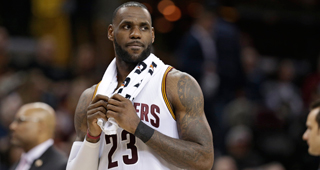When LeBron James left the Cleveland Cavaliers in 2010, Dan Gilbert’s franchise went from breaking even most seasons with an expensive payroll, and luxury tax on top of that, to turning a profit of $33 million during the 10-11 season. Despite being in a financially limited small market, The LeBron Economy was kept in place for that first season without him with Quicken Loans Arena already sold out. Only the Knicks and Lakers made more money that season while the then-Charlotte Bobcats and Memphis Grizzlies each lost $25 million, two of the 15 teams that lost money heading into the 2011 lockout.
After losing more games than any other team in the NBA during his four seasons with the Heat, LeBron returned in 2014 and led the Cavaliers to The Finals and a $24.8 million profit. What happened in Year 2 is already in the cannon of great sports performances with LeBron playing the best three consecutive games of his career to lead the Cavaliers back from a seemingly insurmountable 3-1 deficit against a Golden State team that won a record 73 games.
Now in Year 3, LeBron has been veering in and out of a power struggle against the Cavs that has played out both publicly and privately. The dynamic has been fascinating with LeBron openly questioning the franchise’s commitment to repeating as champions. In the middle of a string of public comments and a meeting with David Griffin, there was a story from Forbes ahead of their annual release of a report on the financials of the NBA that the Cavaliers had lost $40 million during the title-winning 15-16 season.
Cleveland’s financial loss is ranked by Forbes as one of the five biggest in NBA history, behind Brooklyn’s $99 million in 2014, Portland’s $85 million 2003 and $47 million in 2004, and the Knicks’ $42 million in 2007. Paul Allen continues to own the Blazers and he approved making their roster one of the most expensive in the NBA again this past offseason. James Dolan of course owns the Knicks still and made over $100 million last season and the franchise valuation has jumped from $600 million in 2007 to $3 billion today.
There is a near invulnerability to owning an NBA franchise over the long-term from a financial perspective. The current rate of growth for franchise valuations will eventually level off, but they’re one of the surest and most exclusive investments and they also provide the psychic benefit of turning anonymous multi-millionaires into celebrities. They gain entry into an exclusive world of famous people that would otherwise be inaccessible while they also leverage the cachet of owning a sports team into other areas of their investment portfolio.
Dan Gilbert has been savvy enough to profit from many of the ancillary aspects of having a professional sports team in downtown Cleveland by owning the Ritz Carlton and Jack Cleveland Casino. Both ventures benefit greatly by 41 sold out Cavaliers’ regular season games and the additional playoff games. That’s on top of Fathead and his American Hockey League and Arena Football team that also keep the lights on at The Q, which is set to undergo a $140 million renovation that will cost $282 million once the loan is paid off in 2034 with the public paying $160 million of it.
Gilbert is unquestionably competitive and would prefer to win another title, prefer another parade, and even if they can’t repeat, would certainly prefer the playoff gates of four rounds, but there are limits to the cost even for an owner who wants to win as badly as he does. After signing one-plus-one deals in 2014 and 2015, LeBron is now on a two-plus-one contract in which he can’t become a free agent again until 2018 at the age of 34.
Even as the NBA is moving towards reducing minutes, LeBron is playing as many at 32 as he did at 24 with 37.7 per game. LeBron sees the Warriors add Kevin Durant in the offseason and is playing more than three minutes more per game than Durant and Klay Thompson and more than four minutes more than Stephen Curry and Draymond Green.
Tyronn Lue has been forced to play LeBron these minutes after losing Matthew Dellavedova in free agency and Mo Williams to surgery/retirement that cost them a roster spot for half the season. The Cavaliers imprudently paid $1.5 million for the 56th pick in the draft on Kay Felder when they could have had him for free if he remained undrafted for just four more picks.
The Kyle Korver trade allowed Cleveland to finally replace the lost production of J.R. Smith who is out with a broken thumb, but the use of the Anderson Varejao traded player exception signaled costs were being cut. While the $9.6 million TPE would have expired several days before this year’s deadline and the new $4.4 million TPE resets the clock until January of 2018, it severely limits Cleveland’s ability to trade for a player of impact this season.
Cleveland made $24.8 million during LeBron’s first year back and their luxury tax bill, while still significant, will drop this season. Beyond the obvious benefits to all parties with the NBA’s cap spike and the luxury tax threshold hitting $113.3 million, the most meaningful immediate impact was for the Warriors to create enough cap space to sign Durant without gutting their team and for Cleveland to lower their tax obligation.
When Gilbert purchased the Cavaliers in 2005 for $375 million, his net worth was estimated to be $800 million. Today, the Cavaliers are worth at least $1.1 billion and Gilbert is worth $5 billion. It is impossible to determine Gilbert’s true bottom-line, particularly how it is inextricably impacted by LeBron. Even more difficult to determine will be the long-term impact of LeBron on the Cavaliers as this franchise will be dining out on him in perpetuity and the odds of him owning at least a piece of that in retirement are strong.
The financial losses, no matter what they are, are certainly temporary and far from unbearable while the flags fly forever. The Cavaliers will certainly be profitable when LeBron retires or leaves the franchise as they were in 2011, and even more so long-term depending on the number of Finals appearances and titles won.
Because of max contracts, LeBron has never been paid even 50 percent of what he’s worth on the court and as an economy unto himself. The unfortunate reality for a smaller market team is that the luxury tax is infinitely more punitive when they have to pay it even as they benefit when they are on the receiving end because they are fundamentally incapable of generating their own revenue streams through ticket sales, local TV deals and sponsorships that make the economics viable for the likes of the Knicks, Lakers and Warriors.
When Michael Jordan was building and selling out the United Center while delivering six titles for the Chicago Bulls, Jerry Reinsdorf was publicly complaining about how Jordan’s $30 million salary was bad for business and he likened his ownership to “a civic activity.” Gilbert has been far more invested financially and emotionally with the Cavaliers than Reinsdorf ever was with the Bulls, but it is easy to even take transcendent players like LeBron and Jordan for granted. There’s no way to discount how bluntly special it is to have LeBron on your team and there will be no regret for trying to win by all means necessary.



